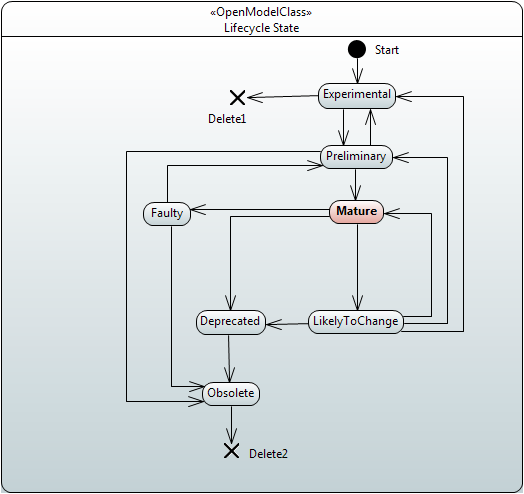It's proposed to adopt the lifecycle stereotype to the resource IM following the IISOMI guidelines.
The following descriptions of lifecycle stereotype are copied from Stereotypes#LifecycleStereotypes.
Lifecycle Stereotypes Definitions
It was noted in the introduction that each phase in the lifecycle of a UML artifact is represented by its own stereotype. The possible stereotypes that can be used to represent the various lifecycle phases are as follows:
- Example
This stereotype indicates that the entity is NOT to be used in implementation and is in the model simply to assist in the understanding of the model (e.g., a specialization of a generalized class where the generalized class is to be used as is and the specialization is simply offered to more easily illustrate an application of the generalized class). - Experimental
This stereotype indicates that the entity is at a very early stage of development and will almost certainly change. The entity is NOT mature enough to be used in implementation. - Faulty
This stereotype indicates that the entity should not be used in new implementation and that attempts should be made to remove it from existing implementation as there is a problem with the entity. An update to the model with corrections will be released. - LikelyToChange
This stereotype indicates that although the entity may be mature, work in the area has indicated that change will be necessary (e.g., there are new insights in the area or there is now perceived benefit to be had from further rationalization). The entity can still be used in implementation but with caution. - Obsolete
This stereotype indicates that the entity should not be used in new implementation and that attempts should be made to remove it from existing implementation. The entity should be kept in the model for at least one further release. The team has to decide on a case by case basis when to remove it from the model. - Preliminary
This stereotype indicates that the entity is at a relatively early stage of development and is likely to change, but is mature enough to be used in implementation. - Deprecated This stereotype indicates that the entity may become obsolete in the near future. It may still be used in new implementation. The entity should be kept in this state for one further release. The team has to decide on a case by case basis when to move it to obsolete.
- Mature
This stereotype indicates that the entity is fully developed and can be used in implementations without any constraints.
One and only one lifecycle state has to be associated to every UML artifact. It is recommended that every new UML artifact is initially annotated with the “Experimental” lifecycle stereotype. (Editor's note: Please note that the initial state of the current model is still under discussion.)
Lifecycle Stereotype State Machine
The associated state machine is as follows:

2 Comments
Jessie S Jewitt
Just a very minor detail. The lifecycle states ARE the applied stereotypes, not something called "lifecycle: XYZ". That's how GenDoc outputs them today. So, as an example, the applied stereotype for an artifact would be "Experimental". Otherwise, it looks like your applied stereotype is "lifecycle".
Zhendong Han
What will trigger these stereotype changements. We should discuss every conditions and make them as clear as possible.